page 2

The female psyche has been painting itself into a corner for years, all the while claiming that the colorful ways in which they have ventured forth in their presumed emancipation and pursuit of greater enlightenment and empowerment are to be interpreted as creative enterprising... even though in most instances it appears they have merely reconstituted an old idea with the language of their respective era. Yet, even though I am about to offer another old idea (of my own), there is no guarantee that most, many or even a few women will be responsive to it... because it requires a left hemisphere approach to analyzing both hemispheres including the reptilian brain... which is compartmentalized with the limbic system. It is one of the three brain aspects which are generalized into three separate categories based on enumeration. The other two are the left and right hemispheres, which is a compilation contrasting with Paul D. MacLean's Triune brain idea which configured the brain in the manner of Reptilian, Limbic system, and Neo-cortex. The illustrations below describe this difference, and portrays how the idea has been painted into a corner by those who have adopted Paul MacLean's view of an evolutionary developing brain to their varying applications of personal interest. (In other words, the usage of a yellow background is to be identified as representing a similar position as the woman with a paint roller in her hand.):

As can be seen in the above image of the brain and multiple images encountered on the internet, viewers are presented with a side-view of the human brain whether intact (looking like a boxing glove or mitten) or as a cut-away dissection model to show different parts or label-assigned areas. This type of thinking is reminiscent in many of the profiles of ancient Egyptian portraits and sculptures, exhibiting a twisted body... perhaps because the Egyptian artists did not know how to convey depth perception in art or that their brains were actually configured to view the world in this fashion, but that from our present day vantage point, we are inclined to think they had the same type of brain functionality and development but simply lacked the artistic talent. If not with a twisted body representation, then they used a full frontal view... though one may encounter images which appear to be closer to our modern sense of depth perception.
Twisted body portrayal |
Twisted body portrayal |
Twisted body portrayal |
Twisted body portrayal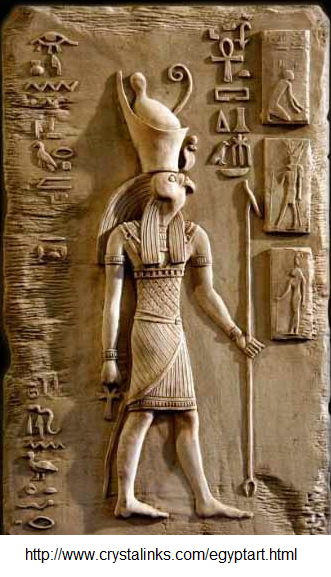 |
Standing at Attention?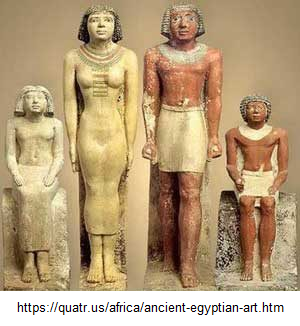 |
Why the stiff, erect posture? (Is this the artists rendition or a profile of cognitive functioning, due to a different brain development?)  |

Apparently, a non-twisted profile? (Mostly animals?) |
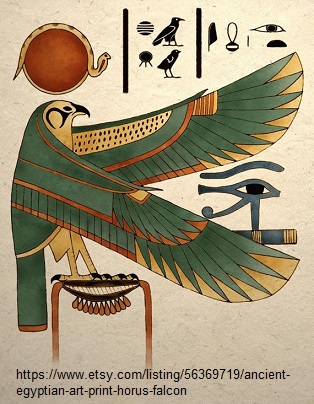
Apparently, a non-twisted profile? (Mostly animals?) |

Apparently, a non-twisted profile? (Mostly animals?) |
By looking at alternative perspectives of the brain, we can come up with an image such as the following:

By using a frontal view of the brain, from the perspective that we have x-ray vision enabling us to see beneath the surface of skin and skull as well as that which may block our view from taking stock of other than the large hemispheres, we come to realize that we can accommodate the rationale of dividing the brain into an alternative triune brain formula, even though there are other viewers who may want to describe greater details for every square inch (or smaller) of the brain, down to each neuron, synapse, and chemistry, if not every atom as well... because they feel such detail equates with a greater level of intelligence (even though they may not personally describe such an elaboration of their ego and self-regard.) The following is one such portrait of the brain:
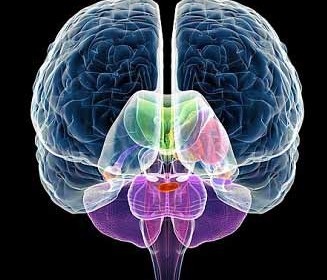
With such a profile in mind, coupled to Paul MacLean's Triune brain model, we can describe the brain in a similar 3-brain pattern of enumeration, except that we number the reptilian complex and limbic system as "1", the right hemisphere as "2", and the left hemisphere as three:
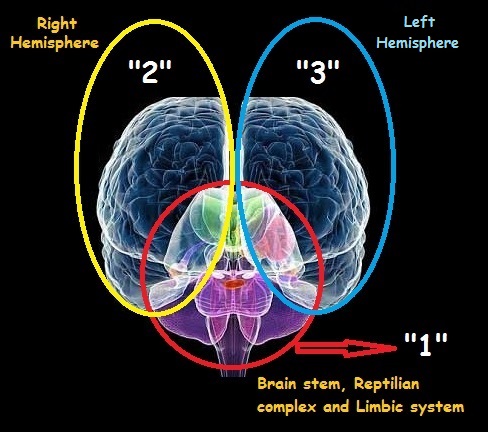
Curiously, for those interested in the Study of the Threes Phenomena, the value of "3" comes up in the perspective that we can find those who identify three common models of the Brain (of which they may be mixed and matched by different users), and should be realized at this juncture in the discussion. Since I found a web page that details the information in a succinct manner, it is of value to replicate the page's contents found at the Interaction Design Foundation web-site:
Three Common Models of the Brain to Help You Develop Better User ExperiencesThere are many different conceptual models of the brain. It’s important to note that many of them lack any scientific basis – this does not, however, negate the fundamental importance of these models. They are not there to "prove" anything but rather to stimulate creative thought as to how designers (and others) may offer all round stimulation of the mind and create better experiences for it. The three most commonly used models of the brain are the left-brain, right brain model, the triune brain model and the system 1, system 2 model. Despite their dubious scientific basis they are still invaluable tools for designers; not as defined ways for the brain to work but rather to contemplate which parts of the psyche we are trying to communicate with and to see if our communications are fully inclusive or intentionally slanted. 1. The Left Brain, Right Brain ModelThe concept of the left brain, right brain model is that the brain is divided into two hemispheres and that one of those hemispheres is "dominant". Thus the idea is that a left brained person may be more logical and objective and a right brained person may be more intuitive and subjective. The theory comes from the work of Roger W Sperry, the Nobel Prize Winner, his research into epilepsy showed that separating the two hemispheres of the brain would reduce the instance of epileptic fits. However, a side effect was that it appeared that the communication pathways of the brain were also affected by this with patients discovering that they could use words processed by one side of the brain but not by the other. Thus the conclusion that logic and language are mainly on the left of the brain and visual and spatial information are dealt with on the right. 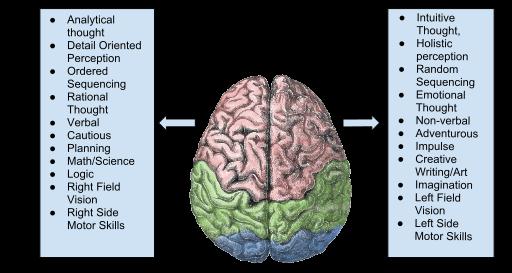 It’s worth noting that current research shows the brain works best in cooperation between the hemispheres. There’s no absolute hemisphere for one kind of processing over another.
Given that the theory isn’t accurate why is it still of use? It’s because there are lessons to be learned from it. If we can identify our strengths and weaknesses, we can learn to play to our strengths and work on our weaknesses. In design it’s helpful to know which group we are catering to with content or design so that we compensate in other places to cater to the other group. 2. The Triune Brain ModelThe triune brain model was first proposed in the 1960s by American physician and neuroscientist Paul D. MacLean and based on research conducted earlier in the century. It was intended to describe the evolution of the mammalian brain but has since been criticized for being over-simplified and possibly inaccurate in several means. The idea is that the brain is split into three parts the lizard brain, the mammal brain and the human brain. 1st) The Lizard BrainThe lizard brain (or reptilian complex) is supposed to be the most basic core of the brain the one that evolved first. It’s said to handle the core of our fight or flight mechanism and to operate on autopilot. In design the ability to communicate with this part of the brain is supposed to enable automated decision making. 2nd) The Mammal BrainThe mammal brain (or more properly the Paleomammalian complex) evolved next. It is the limbic system of the brain. It handles emotions, memories and habits and influences our decision making at both a conscious and sub-conscious level. Designers should, theoretically, be able to appeal to this level of the brain to get users to make decisions which they will justify later. 3rd) The Human Brain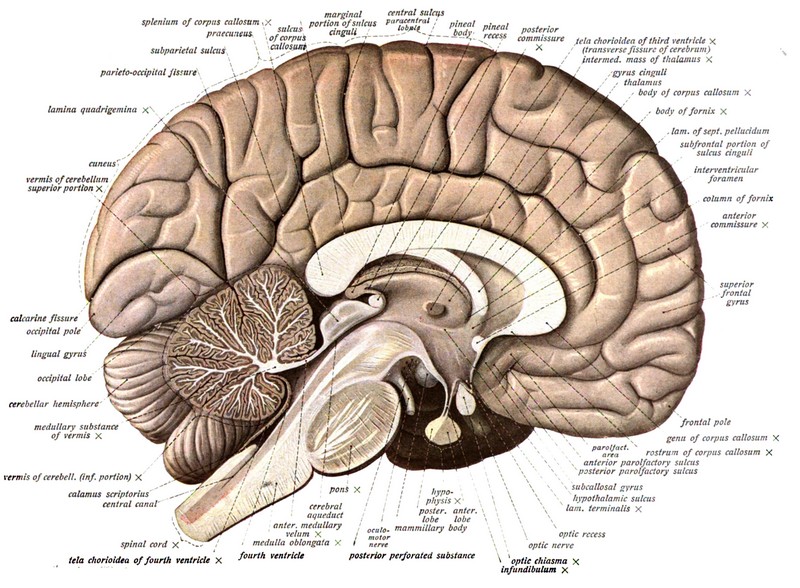
The human brain (or again more properly the Neomammalian complex) is the final step of the evolutionary process. It is found in the neocortex and deals with language, abstract thought, imagination and conscious thought. Its purpose is to reason and to rationalize. The ideal situation for designers is to speak to the two lower forms of brain and have the higher brain rationalize the decision taken by those forms. This model, while flawed, has become very useful in emotional design and user experience design. The ability to communicate with the user at a level below the conscious can be used to drive experiences and useful decisions. 3. The System 1, System 2 Model of the BrainThis model of the brain comes from the 2011 Nobel Memorial Prize in Economics winner Daniel Kahneman. It’s based on research which was conducted over many years. It began with his work in cognitive bias, then prospect theory and finally happiness theory. The idea is simple. He proposes that there are two systems which people think using. System 1 and System 2. These systems were derived through a series of experiments conducted throughout Kahneman’s research. System 1 System 1 is a fast, instinctive and emotional system. System 2 System 2 is slower, more logical and deliberate than System 1. These systems are linked to a series of cognitive biases:
Kahneman’s model is the only model in this article which is not yet disputed by other scientists. This may be because it is a relatively recent model or it may be that it will be shown to be accurate in the long-term. Designers that understand how to tap into cognitive biases can help improve user experiences and business outcomes through those experiences. The Take AwayWhether these models are accurate or not doesn’t matter to the designer. The important thing is that the designer has considered whether their work is appealing to the widest possible cross-section of their audience and that means tapping into the right and left brain, all parts of the triune brain and both systems too. Resources
|
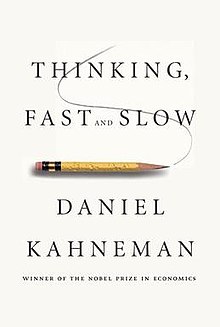
The comments in the "Take Away" conclusion are humorous. Let's itemize a few:
- It's ridiculous to think that the designer of a model doesn't care about accuracy. Of course they do. Whether or not their particular understanding of the brain is accurate or not, that is another matter... but it doesn't mean they aren't sincere. No less, as for developing an idea based solely on what may be described as a Capitalistic mind-set directed towards an intention of using a given model to make money or some other resource accumulation, this is not true for many designers.
- The layout of the hemispheric attributes tells us something about the one or more persons having constructed the lists of examples. They have placed the right hemisphere attributes first and the left hemisphere attributes second, (not to mention naming more for the right than the left suggesting a personal preference for the right than the left)... thus representing a model of accounting in which the hemispheres are viewed from the perspective outside the body, though the appropriate reference, as noted on the previous page regarding orientation, is to view the hemispheres from the driver's seat, so to speak. The use of a box to illustrate the activity of the author(s) gives emphasis to the distinction that might other wise be overlooked if one retains the serialization formula from the original page from whence the information was culled.
- Let it also be noted that the "fast/slow" idea based on cognitive biases describes the state of the human brain for many individuals, but not for all individuals who have different levels and types of mental processing methods which are not adequately described by nor can be comprehensively categorized by a dichotomous portrayal. To suggest that the brain of humans can solely be described as functioning in a dichotomous fast/slow type of thinking analogous to an electronic switching device, overlooks the fact that such a presumed switching mechanism, as recognized in computer programming, is over-layed with a trichotomous brand of Boolean "And- Or- Not" mechanism. Because the human brain can conceptualize such a mode of behavior describes the existence of that which is not accommodated by a simplistic dichotomy. As a model of the brain, the "fast/slow" idea more accurately describes a singular type of cognitive referencing akin to the recognition of ambivalence, which is a hallmark label of schizophrenia, and conveys the interpretation held by many readers that early humans lived in a social atmosphere with a world-view developed by different types of mental functioning that we of today might well view as mental illness or at least some social pathology.
However, the idea of a "System 1" and "System 2" explicated in the "fast/slow" model is of value as basic labels in describing generalities of overall brain structures instead of as an instructor's grading behavior of using check marks placed as identifiers for assuming some inherent predisposition of brain functioning as the Daniel Kahneman model does, so long as we permit ourselves to think outside the primitive's enumeration scheme of a simplistic 1 and 2, whereby we add an additional cognitive category of a "System 3"... whereby:
- System 1 refers to the Reptilian Complex and Limbic System (while not overlooking the spinal cord nor forgetting about the brain vesicles preceded by the notochord preceded by Germ layer differentiation).
- System 2 refers to the right hemisphere interconnected by the corpus callosum.
- System 3 refers to the left hemisphere interconnected by the corpus callosum.
In an attempt to identify concrete differences between the male and female psyche, more definitive efforts have taken place, such as is described in the following image:
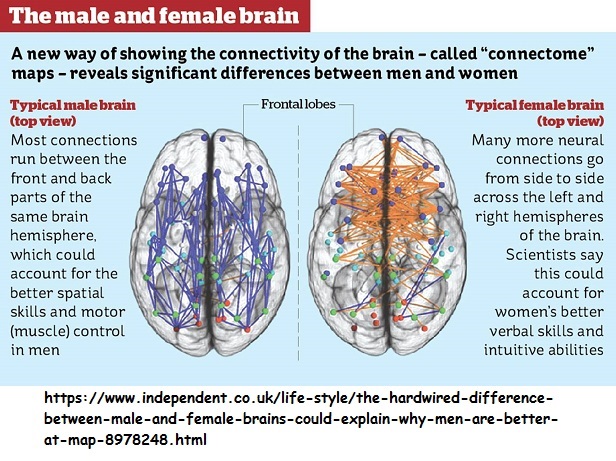
It is because such a distinction can be identified which gives impetus to the idea that the differences in the female psyche can not only be intensified, but elaborated on. For example, image a world constructed which permits the female psyche to develop to its greater potential, instead of having to adapt itself to an environment structured on an unrecognized business, government and religious model that assists men... not necessarily with the intent of enabling men to reach their greater potential, but permits a few men in positions of control to gain more of that which helps them to sustain a level of dominance by asserting the maintenance of an overall public ignorance they are most comfortable with... and asserts itself in different ways to fashion the psyche of those females who happen to achieve a leading social position because they have effectively adopted a female model of the male psyche, and are incorrectly interpreted by female (and some male) supporters as an expression of the female psyche "finally coming unto its own". Whereas in fact, the female psyche has become further buried in the morass of a male psyche paradigm that a few woman have learned to adapt themselves to... thus affirming a generation— if not an institutionalized hierarchy of male-psyche oriented... dominant woman.
Because this situation is the apparent case we are presently faced with by taking stock of many females having achieved some relative position of social preeminence, the female psyche is now confronted by two foes. Those men who knowingly or unknowingly want to perpetuate the world-view nonsense humanity is currently forced to endure, and those women who have adapted a similar world-view strategy in order to make some head-way in such an environment. Like the male psyche which has become institutionalized in so many forms, the female psyche institutionalizes itself in an adaptive fashion thereto. The original or pure female psyche is forced into a servitude from birth... like infants who have had their skulls fashioned by oppressive and ignorant ideas, similar to the practices of foot-binding used by the Chinese, the Yang dominance in the Yin/Yang philosophy, and the breast binding, face/hair covering activities used by various societies in which the male psyche is insecure. And it should be noted, that woman have more often than not been the perpetrators of infanticide. If women can kill babies as part of some socially acceptable custom to go along with a male-psyche dominant world-view, there is little reason to expect such a mental model to change when it comes to accepting the deaths of adults as an acceptable practice... by way of war, economic privations, or simply because they "feel" it serves some greater purpose... from the position of their female oppressed male psyche adaptation. Men have learned how to manipulate women into being the harbinger of death and destruction, as a concealment of the male psyche's ulterior motives of self-survival over all others. Using religion as a means to explain some social practice that results in an oppression that men are not likewise being forced to endure, is an excuse. Then again, religion was initiated long ago a "reasonable" excuse for doing something or not doing something which pleases or displeases men, or those woman effecting their own brand of male psyche control.
Here are but a pin-head size of examples:
- The disturbing reason for the ancient Chinese practice of foot-binding
- Wikipedia: Infanticide
- Defining Gendered Oppression in U.S. Newspapers The Strategic Value of “Female Genital Mutilation” by Lisa Wade, Occidental College
- Patriarchy and the subordination of women from a radical feminist point of view, Ní:na Katrín Jóhannsdóttir
-
Incredible images capture the Ethiopian Suri tribe whose girls have lip plates implanted at puberty as a sign of beauty By Chris Pleasance
- Girl survived tribe's custom of live baby burial (Babies born into some Indian tribes in the Amazon are being buried alive, a practice that is being covered up by the Brazilian authorities out of respect for tribal culture. tradition is based on beliefs that babies with any sort of physical defect have no souls and that others, such as twins or triplets, are also "cursed".) article by Jeremy White in Brasilia
Let's move on to the third page in this area of discussion about brain hemisphere attributes, since laying the ground work has taken more time in the introduction than initially intended.
Page Origination: Wednesday, 24th October 2018... 7:49 AM
Date of Initial Posting: Saturday, 27th October 2018... 7:24 AM